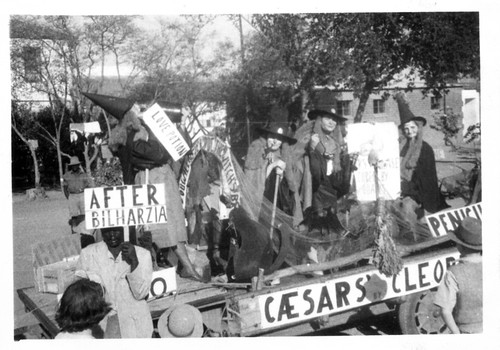The Jubilee Float Parade 1950

Slomans Jubilee Float 1950
Southern Rhodesia was a slow starter by anyone’s standards. Since its founding by Cecil John Rhodes in 1890 its development had been stalled for a host of reasons. Ever present were the host of pestilences which thwarted even the sturdiest of souls. Rindepest, rebellions, Boer War, WWI, and the Great Depression foiled progress in one way or another. Following WWII Great Britain was in ruin. Were the wide-open spaces of Rhodesian a Shangri-La in the making? The nucleus of die-hards and swelling numbers of newcomers alike approached the jubilee celebration with great anticipation.
The Jubilee Float Parade 1950
Que Que celebrated The Jubilee in grand style. Floats were followed by a bicycle parade. Everyone got involved in one way or another from the largest business in town: Slomans, to the smallest, the new hospital, churches and charities. The Globe and Phoenix Mine as well as small workers dotted about the bush, strutted their stuff. Cattle ranchers, maize and tobacco growers generously lent their lorries and then decided to enter the parade themselves.
Slomans Hardware had been around, it seemed, forever. You could count on it for absolutely anything and everything if you only knew your way around. Shoelaces were sold at the sweet counter along with the freshest licorice you ever tasted, gob stoppers and the very finest boxes of Black Magic chocolates. Fifty pound bags of concrete were sold along side 50 lb sacks of mielie meal, chicken feed and fertilizer. Royal Doulton figurines stood on shelves side by side with enamel plates and mugs for the servants. The haberdashery department sported bolts of fabric for dresses and davenports. If you weren’t into sewing and upholstery work then the ladies dress department sold everything from school uniforms to evening gowns. Menswear, of course, sported suits of all sorts: safari to tuxedo, Oxfords to gum boots and mine uniforms, rugby jerseys and cricket and tennis whites. There was a counter for groceries and a wall stacked with liquor.
Slomans was so big that the railway line had a shunting spur right to their lumberyard where they sold steel sleepers to coal and river sand by the ton. If they didn’t have what you wanted on hand they promised to find it for you somewhere in the store. Just give them time. They were stalwarts of the community. You could count on them for support way beyond the store’s demands. Their Stairway to Progress was a sure winner as it carried one of the four Jubilee Queens.
For weeks, the Hospital Sunshine Girls spent much time over tea at ten and two discussing the merits of various themes for their float before making a decision and acting on it. They came in a close second with their float Witchcraft with the boast of Caesars by Cleopatra in their new theatre supported by the first blood transfusion service. Placards warned against the dangers of two of our most endemic diseases: malaria and bilharzias. Most of all they celebrated the discovery of medicine’s marvelous potion of the century: Penicillin (which didn’t address either of these issues but none the less was a cure all for much else that ailed our world).
Anyone who wasn’t floating down the street was cheering from the side lines. Everyone had been involved in some way: donating materials, welding, painting, sewing and so on. A well earned cup of tea, of course, would be served at the end of the parade, along with homemade queen cakes and biscuits of every variety.
Sixty years after the Pioneer Column trekked north, Slomans pointed the way to progress as it floated straight down Main Street (turns were awkward). Their can-do example and generosity were a first class example to the enthusiastic newcomers searching for a new start in life.

